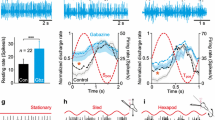Summary
In anaesthetized rabbits, the vestibulo-ocular reflex was evoked by electric stimulation of VIIIth nerve and was observed by recording postsynaptic potentials and relevant field potentials in Illrd nucleus. The electric stimulation of flocculus produced a prominent inhibition of the vestibulo-ocular reflex in both the inhibitory component relayed by the superior vestibular nucleus and the excitatory component mediated by the brachium conjunctivum. The excitatory component mediated by the medial vestibular nucleus appeared to be free of the flocculus inhibition. The flocculus inhibition was blocked very effectively by systemic injection of picrotoxin. That the flocculus inhibitory action is due to monosynaptic postsynaptic inhibition of secondary vestibular neurones was demonstrated by direct stimulation of, and also by recording from, the superior nucleus. Recording from the superior nucleus was also performed in anaesthetized cats. All of these above results indicate that Purkinje cells in flocculus projecting to vestibular and cerebellar nuclei cells have inhibitory synaptic action. Flocculus stimulation produced also an excitatory effect upon vestibular nuclei neurones. However, this effect could be attributed to intracerebellar activation of the primary vestibular fibers which pass into the flocculus.
Similar content being viewed by others
References
Angaut, P., Brodal, A.: The projection of the vestibulocerebellum onto the vestibular nuclei in the cat. Arch. ital. Biol. 105, 441–479 (1967).
Araki, T., Eccles, J.C., Ito, M.: Correlation of the inhibitory post-synaptic potential of motoneurones with the latency and time course of inhibition of monosynaptic reflexes. J. Physiol. (Lond.) 154, 354–377 (1960).
Brodal, A., Høivik, B.: Site and mode of termination of primary vestibulocerebellar fibers in the cat. An experimental study with silver impregnation methods. Arch. ital. Biol. 102, 1–21 (1964).
—, Pompeiano, O.: The vestibular nuclei in the cat. J. Anat. (Lond.) 91, 438–454 (1957).
Dow, R.S.: Efferent connections of the flocculo-nodular lobe in macaca mulatta. J. comp. Neurol. 68, 297–305 (1938).
Eccles, J.C.: The Physiology of Synapses. Berlin-Göttingen-Heidelberg-New York: Springer 1964.
—: The dynamic loop hypothesis of movement control. In: Information Processing in the Nervous System, pp. 245–269. Ed. by K.N. Leibovic. Berlin-Heidelberg-New York: Springer 1969.
— Ito, M., Szentágothai, J.: The Cerebellum as a Neuronal Machine. Berlin-Heidelberg-New York: Springer 1967.
Fernandez, C.: Interrelations between flocculonodular lobe and vestibular system. In: Neural Mechanisms of the Auditory and Vestibular Systems, pp. 285–296. Ed. by G.L. Rasmussen and W.F. Windle. Springfield, Ill.: C.C. Thomas 1960.
Flood, S., Jansen, J.: On the cerebellar nuclei in the cat. Acta anat. (Basel) 46, 52–72 (1961).
Gacek, R.: The course and central termination of first order neurones supplying vestibular end organs in the cat. Acta oto-laryng. (Stockh.), Suppl. 254, 1–66 (1969).
Giorgio Di, A.M., Giulio, L.: Riflessi oculari di origine otolitica ed influenza del cervelletto. Boll. Soc. ital. Biol. sper. 25, 145–146 (1949).
Herrick, C.P.: Origin and evolution of the cerebellum. Arch. Neurol. Psychiat. (Chic.) 11, 621–652 (1924).
Highstein, S.M.: Organization of the inhibitory and excitatory vestibule-ocular reflex pathways to the third and fourth nuclei in rabbit. Brain Res. 32, 218–224 (1971).
—, Ito, M.: Differential localization within the vestibular nuclear complex of the inhibitory and excitatory cells innervating IIIrd nucleus oculomotor neurones in rabbit. Brain Res. 29, 358–362 (1971).
— Tsuchiya, T.: Synaptic linkage in the vestibulo-ocular reflex pathway of rabbit. Exp. Brain Res. 13, 306–326 (1971).
Ito, M.: The mode of integration at the cerebellar subcortical neurones. Proc. XXIV Internat. Physiol. Sci. Vol. VII (1968).
—: Neurophysiological aspects of the cerebellar motor control system. Int. J. Neurol. 7, 162–176 (1970).
—, Highstein, S.M., Fukuda, J.: Cerebellar inhibition of the vestibulo-ocular reflex in rabbit and cat and its blockage by picrotoxin. Brain Res. 17, 524–526 (1970a).
—, Hongo, T., Yoshida, M., Okada, Y., Obata, K.: Antidromic and trans-synaptic activation of Deiters neurones induced from the spinal cord. Jap. J. Physiol. 14, 638–658 (1964).
— Okada, Y.: Vestibular-evoked postsynaptic potentials in Deiters neurones. Exp. Brain Res. 7, 214–230 (1969).
—, Kawai, N., Udo, M.: The origin of cerebellar-induced inhibition of Deiters neurone. III. Localization of the inhibitory zone. Exp. Brain Res. 4, 310–320 (1968a).
— Sato, N.: Cerebellar-evoked disinhibition in dorsal Deiters neurones. Exp. Brain Res. 6, 247–264 (1968b).
—, Obata, K., Ochi, R.: The origin of cerebellar-induced inhibition of Deiters neurones. II. Temporal correlation between the trans-synaptic activation of Purkinje cells and the inhibition of Deiters neurones. Exp. Brain Res. 2, 350–364 (1966).
—, Yoshida, M.: The origin of cerebellar-induced inhibition of Deiters neurones. I. Monosynaptic initiation of the inhibitory postsynaptic potentials. Exp. Brain Res. 2, 330–349 (1966).
—, Obata, K., Kawai, N., Udo, M.: Inhibitory control of intracerebellar nuclei by the Purkinje cell axons. Exp. Brain Res. 10, 64–80 (1970b).
Jansen, J., Brodal, A.: Experimental studies on the intrinsic fibers of the cerebellum. II. The cortico-nuclear projection. J. comp. Neurol. 73, 267–321 (1940).
Kawai, N., Ito, M., Nozue, M.: Postsynaptic influences on the vestibular non-Deiters nuclei from primary vestibular nerve. Exp. Brain Res. 8, 190–200 (1969).
Manni, D.E.: Localizzazioni cerebellari corticali nella cavia nota 2a: Efftti di lesioni delle “parti vestibolari” del cervelletto. Arch. Fisiol. 50, 110–123 (1950).
Obata, K., Takeda, K., Shinzaki, H.: Further study on pharmacological properties of the cerebellar-induced inhibition of Deiters neurones. Exp. Brain Res. 11, 327–342 (1970).
Precht, W., Shimazu, H.: Functional connections of tonic and kinetic vestibular neurones with primary vestibular afferents. J. Neurophysiol. 28, 1014–1028 (1965).
Van Rossum, J.: Conticounuclear and corticovestibular projections of the cerebellum. Assen: Van Gorcum and Comp. 1969.
Voogd, J.: The cerebellum of the cat. Structure and fibre connections. Thesis: Van Gorcum and Comp. 1964.
Wilson, V.J., Burgess, P.R.: Disinhibition in the cat spinal cord. J. Neurophysiol. 25, 392–404 (1962).
Author information
Authors and Affiliations
Rights and permissions
About this article
Cite this article
Fukuda, J., Highstein, S.M. & Ito, M. Cerebellar inhibitory control of the vestibulo-ocular reflex investigated in rabbit IIIrd nucleus. Exp Brain Res 14, 511–526 (1972). https://doi.org/10.1007/BF00236593
Received:
Issue Date:
DOI: https://doi.org/10.1007/BF00236593




